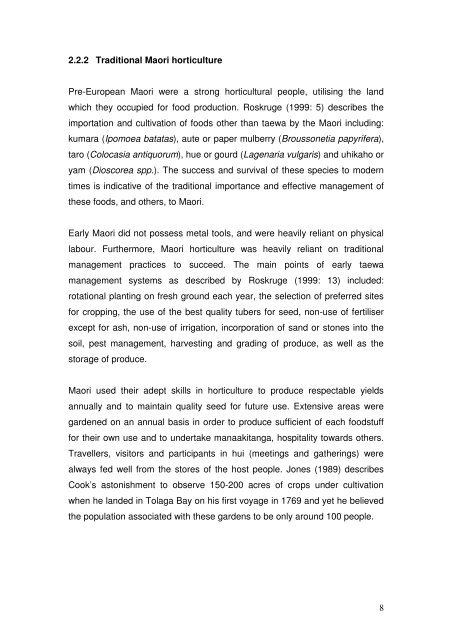Lincoln University Digital Dissertation - Lincoln University Research ...
Lincoln University Digital Dissertation - Lincoln University Research ...
Lincoln University Digital Dissertation - Lincoln University Research ...
You also want an ePaper? Increase the reach of your titles
YUMPU automatically turns print PDFs into web optimized ePapers that Google loves.
2.2.2 Traditional Maori horticulture<br />
Pre-European Maori were a strong horticultural people, utilising the land<br />
which they occupied for food production. Roskruge (1999: 5) describes the<br />
importation and cultivation of foods other than taewa by the Maori including:<br />
kumara (Ipomoea batatas), aute or paper mulberry (Broussonetia papyrifera),<br />
taro (Colocasia antiquorum), hue or gourd (Lagenaria vulgaris) and uhikaho or<br />
yam (Dioscorea spp.). The success and survival of these species to modern<br />
times is indicative of the traditional importance and effective management of<br />
these foods, and others, to Maori.<br />
Early Maori did not possess metal tools, and were heavily reliant on physical<br />
labour. Furthermore, Maori horticulture was heavily reliant on traditional<br />
management practices to succeed. The main points of early taewa<br />
management systems as described by Roskruge (1999: 13) included:<br />
rotational planting on fresh ground each year, the selection of preferred sites<br />
for cropping, the use of the best quality tubers for seed, non-use of fertiliser<br />
except for ash, non-use of irrigation, incorporation of sand or stones into the<br />
soil, pest management, harvesting and grading of produce, as well as the<br />
storage of produce.<br />
Maori used their adept skills in horticulture to produce respectable yields<br />
annually and to maintain quality seed for future use. Extensive areas were<br />
gardened on an annual basis in order to produce sufficient of each foodstuff<br />
for their own use and to undertake manaakitanga, hospitality towards others.<br />
Travellers, visitors and participants in hui (meetings and gatherings) were<br />
always fed well from the stores of the host people. Jones (1989) describes<br />
Cook’s astonishment to observe 150-200 acres of crops under cultivation<br />
when he landed in Tolaga Bay on his first voyage in 1769 and yet he believed<br />
the population associated with these gardens to be only around 100 people.<br />
8
















